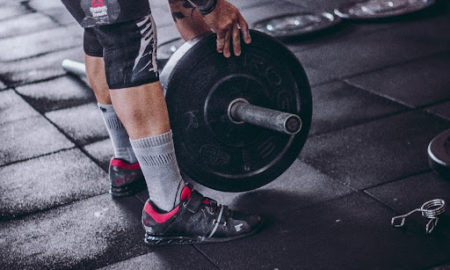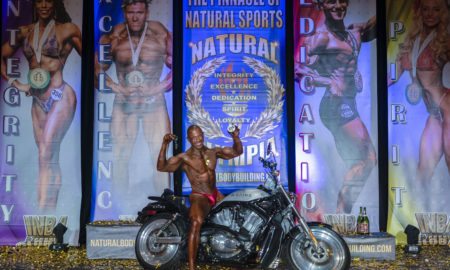Alex Azarian sounded beat. The night before we were scheduled to talk about his shoulder training, he and his wife, Nga, had welcomed Stephen Azarian, all seven pounds, two ounces of him, into the world. I offered via phone message to postpone, but Alex wouldn’t have it. Yes, he was tired; yes, having a baby is much higher on the scale of importance than an interview; and, yes, he had barely slept since the baby was born, but he wanted to do the interview despite all that—because he’d told me he would and he didn’t want to upset my schedule. That provides a little insight into just how nice a guy Alex Azarian is.
He’s also one heck of a competitor, a bodybuilder who, after taking the lightweight title at the ’06 NPC USA, shot to prominence prior to the ’07 Nationals, due primarily to some sick images of his conditioning that led many amateur prognosticators (including yours truly) to predict a win for him going away (see photos on page 144). Unfortunately, it was not in the cards. Alex finished eighth in that competition and got an eye-opening look at just how difficult it is to peak after making a cross-country trip.
What led me to respect Alex after his ’07 Nationals experience was the professional and upstanding manner in which he answered the inevitable question: “What went wrong?” Instead of blaming a mysterious illness or food poisoning or some obscure malady—something that’s common in bodybuilding when a competitor misses his or her peak—Alex calmly admitted that he’d made some poor decisions in the final days leading up to the show. That’s quite a breath of fresh air.
Because of all that I was looking forward to speaking with Alex about how he trains his shoulders. Of course, when you’re speaking of shoulders, you’re really referring to two fairly large muscle groups: the deltoids and trapezius. The development of both groups is key to having a finished physique, and the key to proper development is balance.
Alex told me two things that I found surprising. The first was that, because he’s genetically gifted in his shoulder-and-clavicle area, he stopped training delts for a while, which he later regretted because he felt it affected his physique negatively. The second was that he does his workout with very little rest between sets, even when he’s switching machines.
“I’ve got a full-time job as a teacher and two kids,” he said. “My goal is to get in, beat up the muscle group and get out.”
It’s always refreshing to interview someone who lives a regular, work-a-day existence. Pros who can work out twice a day, five times per week are fun to read about, but there’s very little for the beginning-to-intermediate lifter to take home from that kind of marathon weight sessions. A workout like Alex’s? That’s the sweet spot of weight training.
He begins every delt session with seated front presses, normally done on a Smith machine. On occasion—maybe every third workout—he switches it up and uses dumbbells to stimulate the stabilizing muscles more fully, but for the most part Alex prefers the Smith machine because he feels a better targeted burn. He does around five sets, pyramiding the weight up as his rep count drops, a classic workout style that’s built many impressive physiques.
No need to reinvent the wheel here. Maybe the enduring principles of bodybuilding are enduring because they work. For Alex what works is performing his front presses with moderately heavy weight—50 to 80 percent of one-rep max—working hard until muscle fatigue sets in. Form is important, as is rep speed.
Alex prefers to maintain a moderate rep speed, which lets him focus on moving the weight, not on how fast or where he’s moving it.
“I think it’s important to find a comfortable rep speed and stick with it,” he said. “Too many people try too many different things. That takes away focus from their goal, which is stimulating the muscle to grow.”
After finishing on the Smith machine, Alex quickly grabs a set of dumbbells and begins five rapid-fire sets of lateral raises, again pyramiding up on the weights and down on the reps. His performance style is very much like what he does on the pressing move. “Don’t swing the weights,” he warns. “I don’t care how much you can lift, only that you can lift it correctly.”
Alex’s rules for performance are similar to what many top-level competitive bodybuilders espouse. I’d bet that if you asked 1,000 bodybuilders what is the biggest sin committed by beginning lifters, 999 of them would say, “swinging the weights.” The one guy who answered something different would be either distracted or carb-depleted and not thinking clearly.
Next up for Alex is a trip to the pec deck machine for five sets of reverse flyes, pyramiding the weight. The machine work is a good stimulus for his rear delts, he said. “I quit working rear delts for a while and then later regretted it onstage. That head is key to looking good from the side and looking complete from all angles. So many people ignore their rear delts, yet they’re so important to presenting a complete physique.”
With the pec deck behind him Alex makes his way back to the dumbbell rack to finish his workout. First up is two sets of bent-over lateral raises, with either 25s or 35s, depending on how he feels. He does them with very strict form—total focus on moving the weight up while isolating the rear delts. By this time Alex’s deltoids are fried, so finishing the bent-over laterals with good form is a weekly burn for his shoulders that he feels polishes them off.
“I really focus on the negative movement on laterals—including the standing laterals,” he said. “Maybe not so much on the pressing movements, but focusing on the descending stroke of a flye or lateral is like getting two workouts in one exercise.”
Finally, he moves on to working traps. For years Alex’s big trapezius workout has consisted of shrugs. They work so well, the only variations people use are to attack them from different angles without fundamentally changing the movement.
How people perform shrugs, however, is uniquely personal. Alex uses a pair of heavy dumbbells. He’s so enamored of the way the dumbbells feel and how holding his hands closer to his body helps to stimulate the muscle, he almost never uses an Olympic bar. Find your own way on this one, he said, but be sure to give dumbbells a try.
After all, a shrug is a shrug—you’re pulling the weight up by shrugging your shoulders—but by subtly changing hand positions, you may find something that improves your workout that’s extremely easy to implement.
Alex moved up to welterweight at the ’08 Nationals, to disappointing results and a ninth-place finish. When you next see him compete, it will be this fall, when he’ll make another run for a title—and an IFBB pro card—at the ’09 Nationals in Miami. When he steps onstage, you can be sure of one thing: He’ll have a great pair of shoulders to show the judges. He’ll also be better prepared, having taken to heart the lessons he’s learned over the past couple of years.
His online prep pictures are eagerly anticipated by many pundits, including me, who will probably see them and predict great things for him, again.
Editor’s note: You can contact Alex Azarian through his Web site, PrepByAlex.com, or via his MySpace page, http://www.myspace.com/npc_alex. IM
Alex’s All-Around Shoulder Assault and Training Split
Seated Smith-machine front presses x 5 sets
Dumbbell laterals x 5 sets
Reverse pec deck flyes x 5 sets
Bent-over laterals x 2 sets
Dumbbell shrugs x 5 sets
He uses a standard pyramid scheme, adding weight so that the reps drop, on each successive set on most exercises.
Day 1: Chest, hamstrings
Day 2: Delts, traps, calves, abs
Day 3: Arms, abs
Day 4: Back, calves
Day 5: Quads
*He follows the sequence and takes one or two rest days when his body tells him he needs it or his schedule requires.
















You must be logged in to post a comment Login